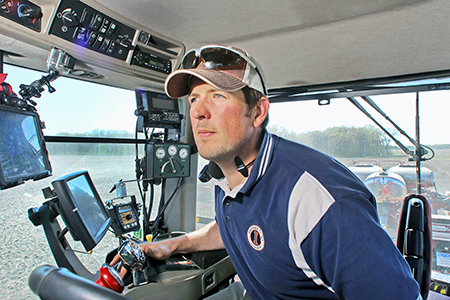This yearlong endeavor looks at how four farmers are evaluating technology and agronomic information that can boost the productivity of their operations.

Weather proved a fickle master for Grant Strom this spring. Already on a dead run to outrace constant rain showers, the west–central Illinois grower watched his planting plans further implode as a tractor went down, followed by the soybean planter.
When his father, Doug, who typically runs the sprayer, ended up in the hospital fighting an infection, Strom could have easily been overwhelmed. Instead, as work windows opened, closed and reopened, he kept going, bouncing ideas off friends, neighbors and suppliers, such as his BASF innovation specialist Dave Phelps.
"I can sit here and wonder and second–guess myself about timing and application and products all day," Strom says. "Instead, I can give guys like Dave a call and find out what he thinks." Phelps works with select growers across a nearly 200–mile–wide region. It's the ability to exchange a range of innovative agronomic ideas that Strom and Phelps both find valuable.
"My strategy for tight margins is to grow more crop. I can't control the market or the weather, but I can lay a foundation for a big crop," Strom says.
Part of that strategy is a strong weed–control program with two or more residuals. It has long proven its merit. With new products or practices, field plots carried out by Strom showcase their performance and add value back to the information exchange. Phelps supports those plots with products he feels have a fit. When Strom cut back on broadcast fertilizer with an in–furrow starter program, Phelps suggested putting in corn plots to test Headline EC and Xanthion fungicides with the starter. More uniform emergence and healthier roots were the goal. Phelps says the treated crop emerged a day or two earlier than untreated.
When it comes to fungicide on corn in–season, Strom is confident of the value of a tassel–stage treatment. However, he has had mixed results with earlier treatments. "I've tried fungicides on corn at the V5 and V7 stages followed by a tassel–stage (VT) treatment," Strom says. "This year, my goal is to lower costs with a one–pass aerial treatment with a VT application on most fields, with V5 or V7 treatments on those a plane can't cover."
Phelps prefers to see a treatment of Priaxor at V5 to V7, followed by Headline Amp at VT on continuous corn fields and corn fields with disease problems. Given Strom’s one–pass program, he is providing some Priaxor for a V10 stage plot. Phelps reports seeing a yield advantage with that treatment over the later VT application if there is an onset of disease prior to VT.
Strom will be able to evaluate the efficacy of the three treatment timings. Like plots with other growers with whom Phelps works, both he and Strom are looking forward to what is learned and can be shared.
"The Innovation Program has given me access to product trials that become a source of information for myself and others," Strom says. "When Dave offers me a product or a recommendation, I know he isn't trying to sell me something. Local retailers and other growers in my network are interested in how these products work. He knows that if I'm not successful with them, it doesn't do him any good."